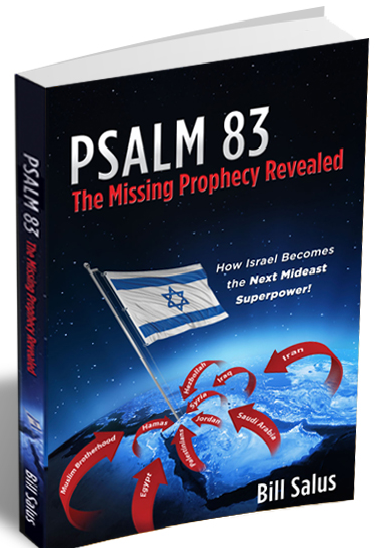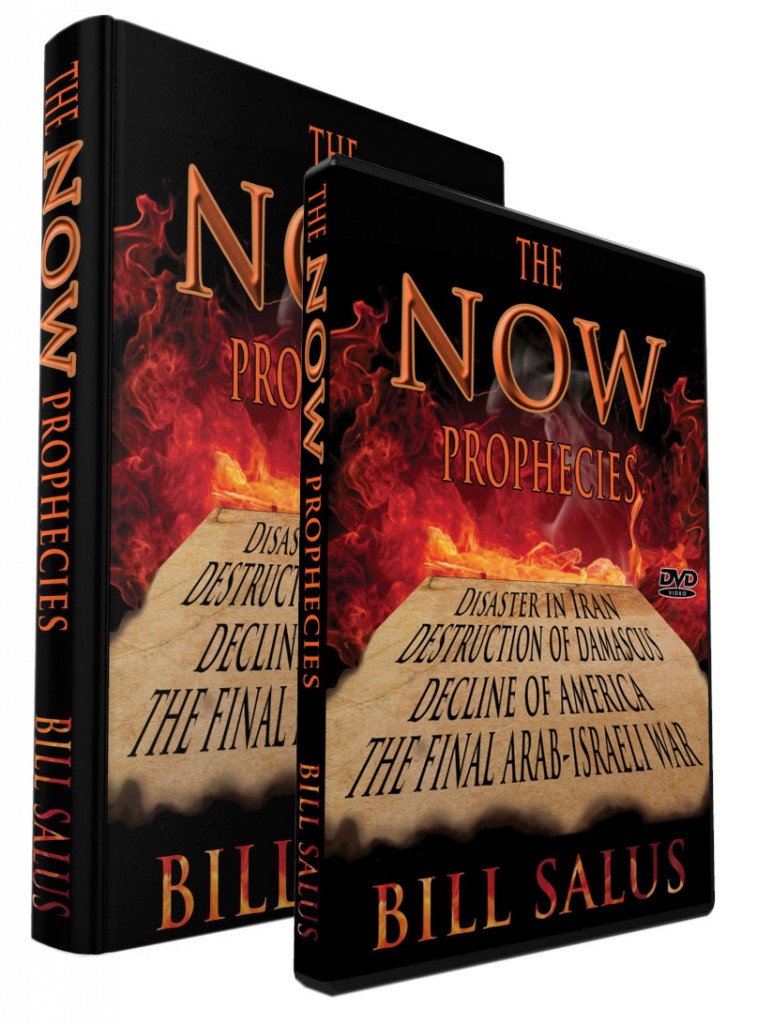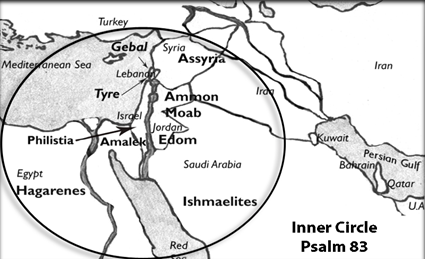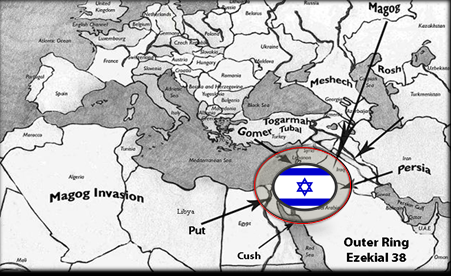Does Psalm 83 Set the Stage for Ezekiel 38?
on Wednesday, August 17, 2016 by Bill Salus This article is revised from the December 3, 2009, article of the same name.
This article is revised from the December 3, 2009, article of the same name.
Current Mideast rumblings have many eschatologists revisiting a prophetic psalm that had been vastly overlooked. It’s the 83rd Psalm and it discusses the formation of a ten member Arab confederacy destined to someday seek the utter destruction of the nation Israel. Psalm 83 mostly popped up on the prophetic radar screen with the 2008 release of my book entitled Isralestine, The Ancient Blueprints of the Future Middle East. The updated version of this book called, Psalm 83: The Missing Prophecy Revealed, How Israel Becomes the Next Mideast Superpower, was published in 2013.
…………………………………………………………………
CLICK HERE TO READ PSALM 83 ONLINE
…………………………………………………………………
The psalm was authored by Asaph, approximately 3000 years ago, at a time in Israel’s history when King David reigned, the Israelites were preparing to build their first temple, and the nation as a whole was divinely blessed and empowered. We are told in 2 Chronicles 29:30 that Asaph was a seer, chozeh in the Hebrew, meaning he was a prophet in the vein of Isaiah, Jeremiah and Ezekiel.
At a divinely blessed point in Israel’s history, Asaph received his genocidal vision of Israel’s possible destruction. This daunting prophecy must have disturbed the Israelites at the time since most of the confederates were comprised of surrounding populations that had demonstrated a sincere hatred toward them at various points throughout their history. Additionally, Assyria, one of the ten confederate members, was becoming a conquering empire to the Northeast of Israel at the time. These populations are listed in Psalm 83:6-8 and are connected with their modern day equivalents later in this article.
The seer inscribed his vision in the customary imprecatory prayer format intending to invoke the curse for curse in kind clause spelled out in Genesis 12:3 upon this coming confederacy. The essence of Asaph’s petition reminds God that any genocidal attack upon His people, ultimately serves as an assault against His covenant making character as per the Abrahamic Covenant. Within this unconditional covenant was the promise that Abraham would father a great nation and have descendants with a homeland forever as per Genesis 13:15-17, 15:17-18 and elsewhere.
Psalm 83:4 tells us that the Arabs want to destroy the Chosen People, and Psalm 83:12 informs us they want to possess the Promised Land. Thus, Asaph petitions God for the destruction of this confederacy by empowering the Israelites militarily through similar historical examples given in Psalm 83:9-11. The biblical correlation is that these enemies want to destroy Israel militarily, so therefore they should similarly be cursed militarily. The significance of these specific historical examples will be sited subsequently in this article.
In addition to, and concurrent with the increased prophetic chatter about Psalm 83, many eschatologists feverishly flip through the final pages of the end time’s calendar to arrive at the Ezekiel 38 & 39 prophecy. In the process they tend to skip over Psalms 83 and potentially other pre Ezekial 38 prophetic scriptures found in Jerermiah 49, Isaiah 17 and 19. The Ezekiel 38 prophecy also predicts the formation of a powerful confederacy destined to someday invade Israel apparently led by Russia. Ever strengthening relationships between Russia and the Ezekiel 38 listed nations of Iran and Turkey appear to be among some of the reasons behind this EZEKIEL 38 NOW fervor!
 In spite of the fact that the Israel today does not appear to meet all the prerequisites contained in Ezekiel 38:7-13, many notable scholars are convinced that current geopolitical circumstances in the region favor the nearby fulfillment of this prophecy. In a previously released article, “Psalm 83 or Ezekiel 38, which is the Next Mideast News Headline,” I list the litany of possible reasons why modern day Israel does not presently meet the prophetic Ezekiel 38 prescription. This information is also encapsulated in my NOW PROPHECIES book and DVD.
In spite of the fact that the Israel today does not appear to meet all the prerequisites contained in Ezekiel 38:7-13, many notable scholars are convinced that current geopolitical circumstances in the region favor the nearby fulfillment of this prophecy. In a previously released article, “Psalm 83 or Ezekiel 38, which is the Next Mideast News Headline,” I list the litany of possible reasons why modern day Israel does not presently meet the prophetic Ezekiel 38 prescription. This information is also encapsulated in my NOW PROPHECIES book and DVD.
In addition to modern day Israel’s probable prophetic unpreparedness for the Ezekiel invasion to occur presently, there is another large dilemma that the EZEKIEL 38 NOW advocates are grappling with. Namely, the “inner ring” of Arab nations sharing common borders with Israel who have been Israel’s most observable enemies since 1948, as they are not listed among the Ezekiel invaders.
In my opinion, the difference in the lists, which are shown further on in this article, is because the inner ring of Arab states have been defeated by the Israeli Defense Forces prior to the Ezekiel invasion and therefore the names do not appear on Ezekiel’s list. In other words, they are eliminated, never again to muster a military force. Others have suggested that the difference may be accounted for in an Arab refusal to participate in the invasion due to historical animosities with the Persians (Iranians) who are allied with with the Russians in the Ezekiel invasion. But, it seems to me that the Arab states are highly unlikely to sit out a major offensive against Israel when they would have so much to gain as a result.”
Others have dealt with the issue by crossing the territorial divides and imaginatively inserted ancient Arab populations like Tyre, Aram, Asshur, and Philistia into the Ezekiel 38:2-6 equation. This tendency, not scripturally supported, seems to be fueled by Iranian relationships with Hezbollah (Tyre), Syria (Aram / Asshur), and Hamas (Philistia), which are also at an unprecedented high. As stated earlier, Iran is a key player among the Ezekiel invaders.
When Ezekiel wrote he did not have names like Russia, Iran, Turkey, Libya, Hezbollah, and Hamas, in his vernacular. Thus he referenced Rosh, Magog, Persia, Meschech, Put, etc. to describe modern day Russia, Iran, Turkey, Libya, and nine populations in total. However, nowhere included in Ezekiel’s list of populations are Tyre, (Lebanon), Asshur (Assyria), Philistia (Gaza), etc. Those populations appear to be reserved for the Psalm 83 Arab – Israeli war.
This is not to say Ezekiel couldn’t have listed the Psalm 83 conspirators alongside the Russian led consortium, since he references most all of the Psalm 83 populations elsewhere throughout his prophetic book. This suggests two things: one, that Ezekiel had their ancient names within his vocabulary, and two, that they aren’t part of the Ezekiel 38 & 39 invasion.
Below are two tables and two maps that generally identify and locate the participants of the Psalm 83 “inner ring” of Arab confederates, and the Ezekiel 38 “outer circle” Russian coalition. The circular borders distinguish the Ps. 83 inner ring from the Ez. 38 outer circle. These illustrations depict two distinctly different confederate groupings. These exhibits are intended to loosely rather than precisely identify the pertinent populations and / or locations. Some scholars present differing views as to who the participants are in each prophetic event.


Since the summer 2008 release of my book Isralestine, the Ancient Blueprints of the Future Middle East, in which Psalm 83 is the central theme, several theories as to the nature and timing of the Psalm have surfaced. Some of these theories previously existed; however, a few seem to be relatively new. The main theories espoused that I have uncovered thus far as to the Psalm and / or its timing are:
1. It found historical fulfillment in 2nd Chronicles 20
2. It found historical fulfillment in the war of 1948
3. It found historical fulfillment in the war of 1967
4. It is about to find final fulfillment prior to Ezekiel 38 (Bill Salus hypothesis)
5. It will find fulfillment within Ezekiel 38
6. It will find fulfillment after Ezekiel 38 but prior to the Armageddon Campaign
7. It will find fulfillment within the Armageddon campaign.
8. It is an imprecatory Psalm and not a specific prophecy per se
In addition to comparisons already given, the rest of this article will be devoted to addressing the seemingly clear distinctions between the Psalm 83 and Ezekiel 38 & 39 Israeli war prophecies and why they probably won’t occur concurrently as per theory number #5 above. On a side note, although Ezekiel 38 & 39 is comprised of fifty-two passages and Psalm 83 a mere eighteen, it is my contention that when all Psalm 83 inter-related prophetic passages are discerned, much more detail is given in the Bible about the Psalm than the Ezekiel invasion. Thus the Psalm, generally overlooked by scholars until recently, is now beginning to receive the serious study it deserves.
Ezekiel 38 & 39 generally details the whole Israeli war episode from start to finish, whereas Psalm 83 gives far less detail. Thus it becomes incumbent upon the eschatologist to diligently search the entirety of scripture to find out how the LORD intends to deliver Israel through the climactic concluding Arab Israeli war prophecy.
We can conclude that it very well could be the final effort of the Psalm 83:6-8 confederates to destroy Israel by reviewing the end results of the historical examples Asaph references in Psalm 83:9-11. A careful review of the historical Israeli war events Asaph alludes to takes the reader primarily to the accounts recorded in Judges Chapter’s 4 through 8. Upon reviewing these chapters and appropriately aligning the events described therein with recorded history, one concludes that once those former enemies of Israel were defeated, they ceased to ever oppress the Israelites further. Similarly the inference can be made by Asaph’s specific petitioning that once the Israelites, or should the event occur soon, the Israeli Defense Forces, defeat the Psalm 83 confederates, they likewise will cease to ever collectively oppress Israel further.
For article brevity sake below please find an abbreviated list of further distinctions between Psalm 83 and Ezekiel 38 & 39…
The two prophecies have distinctly differing mandates, motives, and destructions. The Ezekiel confederates want to destroy Israel in order to take spoil and things of great value (Ez. 38:13). The Psalm 83 Arabs seek sole possession of the Promised Land (Ps. 83:12).The Ezekiel invaders are divinely defeated (Ez. 38:18-39:6), whereas Israeli Defense Forces (I.D.F.) destroy the Arab conspirators (Ps. 83:9-11, Ez. 37:10, 25:14, Obadiah 1:18 and elsewhere). In fact, this appears to be the only significant prophetic role the I.D.F. of today has. They are not instrumental in the Ezekiel 38 & 39 episode or the concluding Armageddon Campaign of the Antichrist at the end of the Tribulation Period.
Psalm 83 has ten populations (Ps. 83:6-8) and Ezekiel has only nine distinctly different populations (Ez. 38:2-6). Those who suggest Psalm 83 and Ezekiel 38 are the same prophetic event bear the burden of proof of locating the Psalm 83 confederates inside the Ezekiel invasion. They must locate the inner ring within the outer circle, and avoid the tendency to sensationalize present Russian, Iranian, Turkish, and Libyan relationships.
In the aftermath of Psalm 83 and Ezekiel 38, humanity is delivered two distinctly differing lessons. Psalm 83 teaches humanity that God’s Genesis 12:3 foreign policy is still effectually intact, and Ezekiel 38 displays God’s glory and informs humanity that God is real, sovereign and extremely powerful (Ez. 39:7).
Regarding the Psalm 83 lesson, the lead member of Psalm 83 is the tents of Edom, who are probably representative of the Palestinian refugees today according to my studies published in Isralestine’s Whodomite chapter. The Edomites are the descendants of Esau (Genesis 36:1), who was Jacob’s twin brother. Jacob was renamed Israel in Genesis 32:28. The lesson for humanity in the aftermath of Psalm 83 is that if God did not spare the descendants of Jacob’s own twin brother Esau for cursing the Jews, then how can anyone be spared of a similar fate for attempting the same. Thus the Abrahamic Covenant is demonstrated through the I.D.F. destruction of the Psalm 83 confederates to still be effectually intact.
There are distinctions between the battlefronts as well. The Ezekiel invaders originate from the uttermost parts of the north (Ez. 38:6) whereas the Arab’s encircle Israel from all sides. The Psalm 83 battlefront appears to be the floodplains of the Jordan as per the possible connecting prophecy found in Jeremiah 49:19.
Lastly, Dedan appears to abstain from enjoining the Ezekiel invaders (Ez. 38:13). Dedan was located in the Northern part of Saudi Arabia. Yet, in Psalm 83, Saudi Arabia appears to be involved under the banner of the Ishmaelites (Ps. 83:6). This somewhat confuses the argument that Ezekiel 38 and Psalm 83 are one and the same prophetic event. Otherwise, why would Saudi Arabia participate in Psalm 83, but opt out of Ezekiel 38? Additionally, Dedan is located within the Ezekiel 25:13-15 sequence, which appears to be part of God’s response to Psalm 83.
In conclusion, Psalm 83 and Ezekiel 38 are two distinctly differing Israeli war prophecies. Psalm 83 is more than a mere imprecatory prayer, but is an actual confederate effort, with listed participants, a specific mandate, and a genuine motive. Both events are yet to find final fulfillment, but appear likely to be about to occur soon, sequentially, and in rapid succession. In the aftermath of Psalm 83, Israel probably develops without much restriction, into the sovereign Jewish State that the Ezekiel invaders seek to invade.


